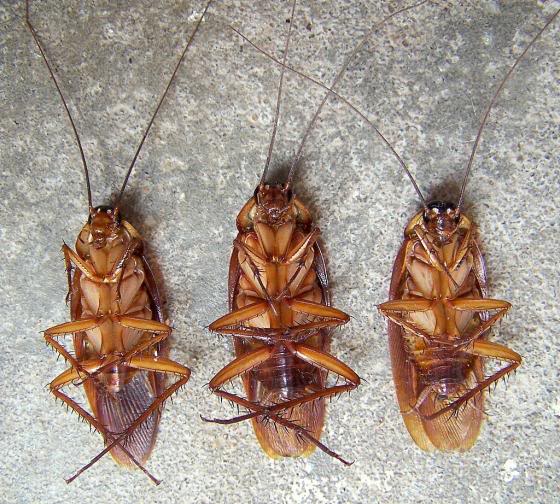Understanding Cockroach Behavior
Curious why you often see roaches belly up when they kick the bucket? Let’s get into this flip of events and understand what causes these pesky insects to go belly-up.
Cockroach Flipping Phenomenon
Nobody likes finding roaches wiggling their legs in midair on your kitchen floor. It’s a weird scene, but there’s a reason for this insect gymnastics, involving their physical setup and the places they hang out.
High Tipping Point: Think of a top-heavy cockroach on a tightrope—yep, they can easily tip over. Their goofy high center of gravity means when their muscles say bye-bye, their bodies have a wonky way of flipping over.
Spasms from Hell: When they’ve snacked on some bug spray cocktails, roaches lose their sense of direction. Those nasty chemicals mess with their heads, sending them into muscle spasms that flip ’em belly-up.
Factors Leading to Upside Down Position
A handful of things team up to leave cockroaches doing the backstroke when life ends:
| What Happens? | Why It Happens |
|---|---|
| Slippery Dance Floor | Surfaces smoother than silk like linoleum can send roaches skating into upside-down disaster. Older or limping bugs find it tricky to turn back over. |
| Toxic Mixers | Roaches unwisely party with chemicals in bug sprays, which zap their nerve control and leave them spinning around aimlessly. |
| No Handholds | It’s a game of survival on bare floors with nothing to hold onto; roaches can’t put themselves back the right way up on these surfaces (Quora). |
| Home Sweet Home Hazards | Our homes aren’t built for insect recovery, and their lack of traction on smooth floors leaves these bugs SOL once they’re flipped. |
So there you have it—cockroaches die belly-up thanks to their peculiar body shape and sticky issues in the crib. For more dirt on what keeps roaches busy in the wee hours or how they bolt so fast, mosey over to why do cockroaches come out at night and how fast can cockroaches run.
Environmental Factors for Cockroaches
Cockroaches are like the little tanks of the insect world. They’re tough, but things around them can still affect how they roll—or flip over, for that matter. Let’s talk about what makes these creepy crawlies end up belly-up.
Impact of Flooring Surfaces
Imagine a bug race on a kitchen floor. On slick tiles or shiny wood, cockroaches play slip-n-slide against their will. These surfaces can turn into a skating rink for their tiny legs, which makes flipping back over as tricky as a dog with no traction on a linoleum floor. So, if you see a roach doing a breakdance move, it’s partly because your house floor makes it tough for them to find their feet again.
But give ’em something rougher, like a gritty concrete or a rugged rug, and they’re more likely to regain their balance and scurry away. The kind of flooring in your home is a big deal to these hustling bugs.
Effects of Toxins and Pesticides
Pesticides are the ultimate party poopers for roaches. Their little nervous systems get scrambled, and it’s all downhill from there. Imagine if drinking too much coffee made you fall over and stay that way—same story. These big bad chemicals zap their control and coordination, leaving them flailing like they’re in an invisible hamster wheel.
The spasms, wobbles, and eventual freeze-up provide that iconic roach-on-its-back sight. It’s kind of like their last dance. For those interested in giving roaches their final send-off, check out some tips to fumigate those guys.
Need for Resources: Water and Food
Roaches are like the camels of the bug world, lasting a good month without a bite—but they’re thirsty critters needing water way sooner. Starve them of their aqua fix, and their roachy days are numbered. A dry spell means their oomph to flip back vanishes, leaving them more prone to play log on your bathroom floor (Terminix).
Here’s the roach survival guide:
| Resource | Days Without |
|---|---|
| Food | About 30 days |
| Water | Around 10 days |
When it’s desert-time for these bugs, don’t expect them to stay upright.
To sum it up: floors that feel like butter, bug-busting chemicals, and a lack of H2O and chow are what push these critters to their final flop. For more about why they seem to come out and party all night, or how and when their numbers might explode, check out other tidbits on night-roaming roaches and roach reproduction madness.
Cockroach Mortality Factors
Ever wonder why cockroaches often meet their end belly-up? Let’s take a peek into those final, ungraceful moments.
Natural Causes of Death
Out in the wild, cockroaches stumble upon various fatal threats. Extreme temperatures and a lack of essentials, like water, can put a serious damper on their survival. Now, these critters can go on a fast like nobody’s business, but deny them water and it’s game over real fast. Their lifespan can stretch from just a few months to several years.
Mother nature also throws in diseases and parasites to keep them on their toes. Fungal infections, the odd bacterial invasion, and parasitic wasps are the kind of enemies that can wipe out cockroach communities without much fuss (Terminix).
Predator Threats in the Wild
Life’s a jungle for cockroaches, as they’re on the hit-list of many predators. From the sky and the ground, birds, amphibians, reptiles, and even mammals see roaches as a tasty snack. Predators play a big role in keeping their numbers in check (Terminix).
| Hungry Hunter | Examples |
|---|---|
| Birds | Feathered friends like small forest birds, hawks |
| Amphibians | Jumpers like frogs, toads |
| Reptiles | Scaly foes like lizards, snakes |
| Mammals | Sneaky rats, and the bigger beasts |
Aging and Disease Impact
Cockroaches don’t escape the grim reaper; they age too. Their clock ticks for months, maybe years, but eventually, they slow down. As they get on in age, dodging danger gets harder. Add in some diseases or pesky parasites, and they don’t stand much of a chance (Terminix).
Aging is one reason you find cockroaches upside down on your floor. As they become feebler, they can’t handle slick surfaces like linoleum or polished hardwood— it’s like the floor’s out to get ’em, and once they tip over, that’s often it (Discovery Place).
Curious about how these resilient rogues can still roam headless? Check out our piece on how cockroaches survive without heads for some jaw-dropping facts. And if you’re wondering why they’re night owls, read our article on why do cockroaches come out at night to understand how their night-time antics are a crafty survival strategy.
Cockroach Resilience and Adaptations
Cockroaches are the ultimate survivors in the pest world, thriving where many others fail. Let’s take a peek into their survival toolkit—what makes them so hard to send packing—and their signature moves in dodging environmental bullets.
Survival Strategies of Cockroaches
These little critters are night owls, only coming out when everyone’s asleep to dodge both predators and people. And boy, can they eat anything! From your pizza crusts to toothpaste, their diet’s like a junk food lover’s paradise.
Then there’s their love life—or rather, their knack for multiplying like rabbits. Cockroaches lay loads of eggs, and before you know it, their offspring are all grown up and ready to party, making any infestation a real headache.
Resilience to Environmental Extremes
While roaches are all about tropical vibes, they can pull some crazy stunts when things get tough. Sure, extreme heat or cold isn’t their jam (do cockroaches prefer hot or cold), but they can survive stuff that would leave other critters eating dirt.
For example, these bugs laugh in the face of radiation levels that would have us humans running for the hills (Discovery Place). And you try drowning one? They’ll hold their breath for a solid 30 minutes like it’s no big deal.
Unique Features and Abilities
Cockroaches are armed with some peculiar tricks. Imagine rocking a headless look for 10 days! They manage because they breathe through holes in their sides rather than their heads (Discovery Place).
Plus, they’re tricky little speedsters, darting around faster than most folks can stomp. Add their tiny size and dark-loving ways, and you’ve got one slippery pest to pin down.
These traits make cockroaches not just survivors but pesky opponents for anyone trying to boot them out of the house. Getting to grips with these quirks is key if you’re in the fight against them.
For more tales of cockroach cunning, check out our reads on why are cockroaches hard to kill and how do cockroaches survive without heads.
Risks Associated with Dead Cockroaches
Allergies and Asthma Triggers
When it comes to allergies, those pesky cockroaches, even when dead, can be a real nightmare. Their leftover body bits, exoskeletons, and droppings hang around like that bad smell you can’t place – they can seriously set off both allergies and asthma. For folks already dealing with respiratory issues, these creepy crawlies can trigger severe asthma attacks and allergic reactions, much like an unexpected slap in the face.
| Health Problem | Trouble Source |
|---|---|
| Allergies | Roach bits, shells, droppings |
| Asthma | Roach allergens |
Take a gander at can cockroaches cause allergies to dive deeper into how these critters mess with your breathing.
Bacterial Contamination and Pathogens
Ah, the ever-charming dead cockroach. They’re like those uninvited guests who’re full of germs and never leave. Dead roaches can tote around bacteria and other nasties, being the life of the party in all the wrong ways. They can spread these germs onto surfaces, especially in places where you’re whipping up food. Gross, right? Keeping your space clean and chucking dead roaches out pronto can help sidestep this germy inconvenience.
| Germy Threat | What’s to Blame? |
|---|---|
| Bacteria | Roach bodies, poop |
| Germs | Including E. coli and Salmonella |
Check out what diseases do cockroaches carry to learn what these critters might be hauling around.
Attraction of Other Roaches
Here’s something a bit backwards: dead roaches actually bring more roaches. Yep, these scavenging critters can’t resist a dead buddy’s buffet. The smells they emit are like a dinner bell ringing for other cockroaches, often luring them to join the party and cause a bigger infestation.
| Situation | Result |
|---|---|
| Dead roaches | Invite more roaches |
For down-to-earth tips on booting cockroaches out and making sure they don’t roll out the welcome mat again, peek at our pointers over on how to stop cockroaches coming back.
Understanding these grubby risks helps anyone drowning in roaches make healthier, tidier choices. Check out more smart moves on dealing with them pests in articles like how to fumigate house cockroaches and how to use boric acid kill cockroaches.

